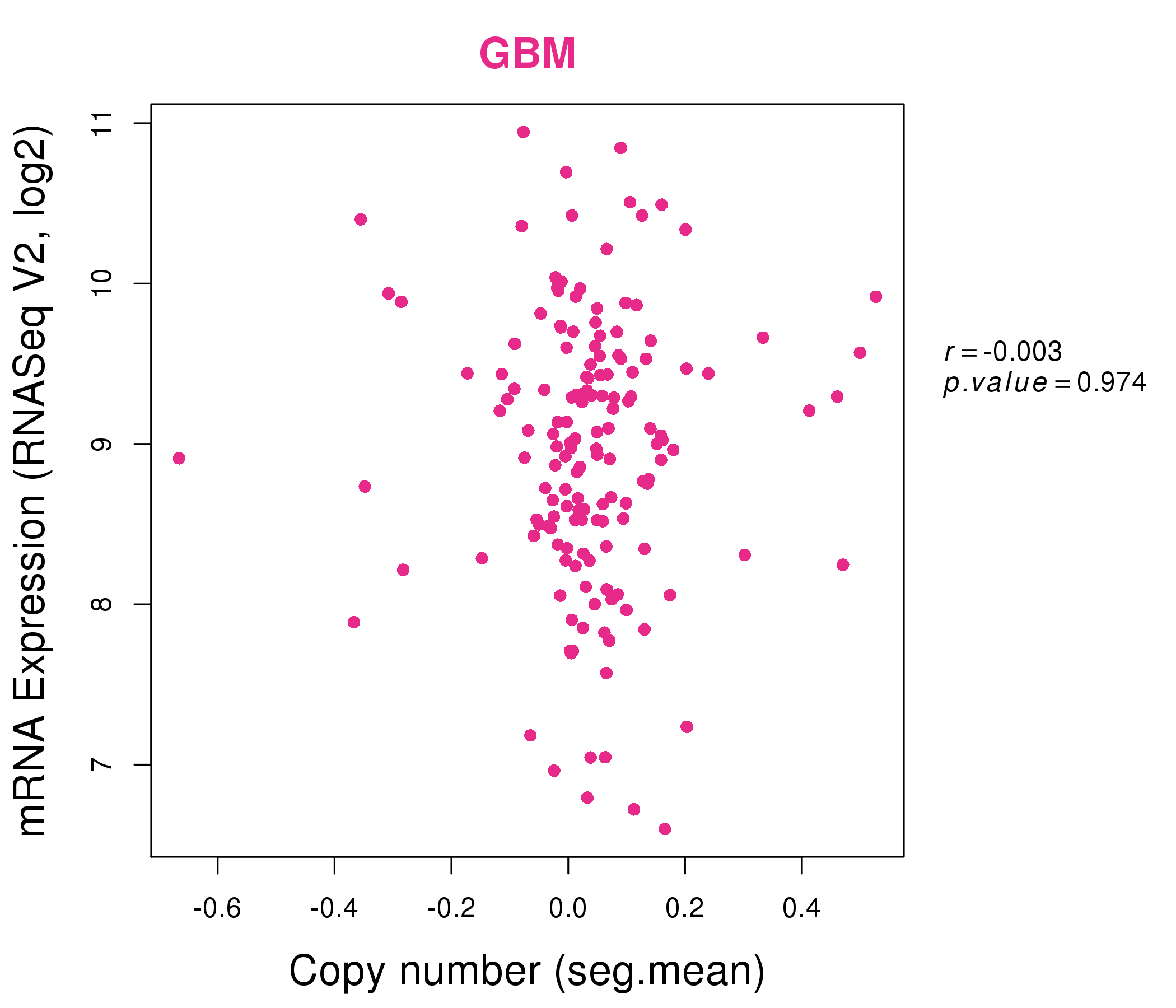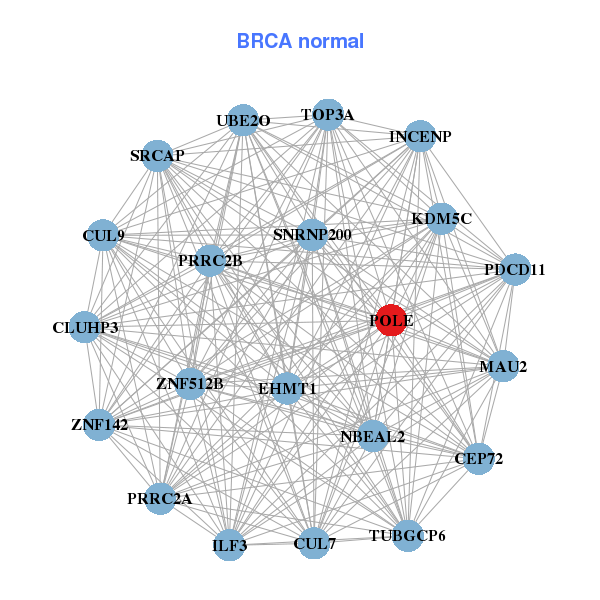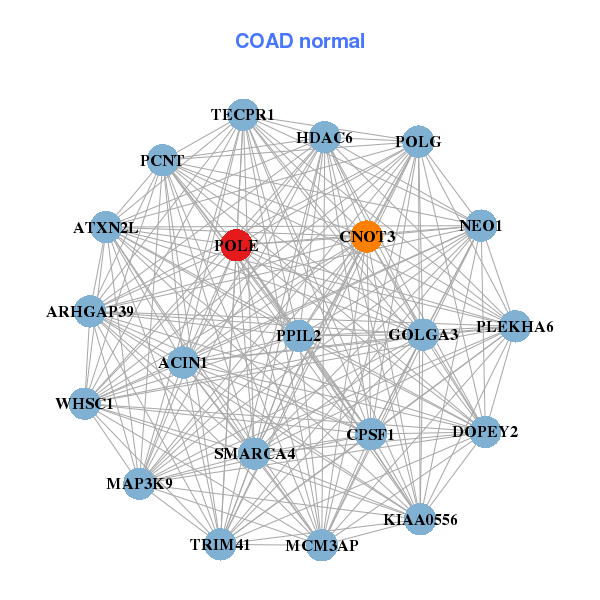|
||||||||||||||||||||
| |
| Phenotypic Information (metabolism pathway, cancer, disease, phenome) |
| |
| |
| Gene-Gene Network Information: Co-Expression Network, Interacting Genes & KEGG |
| |
|
| Gene Summary for POLE |
| Top |
| Phenotypic Information for POLE(metabolism pathway, cancer, disease, phenome) |
| Cancer | CGAP: POLE |
| Familial Cancer Database: POLE | |
| * This gene is included in those cancer gene databases. |
|
|
|
|
|
| . | ||||||||||||||
Oncogene 1 | Significant driver gene in UCEC 6, | |||||||||||||||||||
| cf) number; DB name 1 Oncogene; http://nar.oxfordjournals.org/content/35/suppl_1/D721.long, 2 Tumor Suppressor gene; https://bioinfo.uth.edu/TSGene/, 3 Cancer Gene Census; http://www.nature.com/nrc/journal/v4/n3/abs/nrc1299.html, 4 CancerGenes; http://nar.oxfordjournals.org/content/35/suppl_1/D721.long, 5 Network of Cancer Gene; http://ncg.kcl.ac.uk/index.php, 6 http://www.nature.com/nature/journal/v497/n7447/full/nature12113.html, 7Therapeutic Vulnerabilities in Cancer; http://cbio.mskcc.org/cancergenomics/statius/ |
| KEGG_PURINE_METABOLISM KEGG_PYRIMIDINE_METABOLISM | |
| OMIM | 174762; gene. 615083; phenotype. 615139; phenotype. |
| Orphanet | 352712; Facial dysmorphism - immunodeficiency - livedo - short stature. |
| Disease | KEGG Disease: POLE |
| MedGen: POLE (Human Medical Genetics with Condition) | |
| ClinVar: POLE | |
| Phenotype | MGI: POLE (International Mouse Phenotyping Consortium) |
| PhenomicDB: POLE | |
| Mutations for POLE |
| * Under tables are showing count per each tissue to give us broad intuition about tissue specific mutation patterns.You can go to the detailed page for each mutation database's web site. |
| - Statistics for Tissue and Mutation type | Top |
 |
| - For Inter-chromosomal Variations |
| There's no inter-chromosomal structural variation. |
| - For Intra-chromosomal Variations |
| There's no intra-chromosomal structural variation. |
| Sample | Symbol_a | Chr_a | Start_a | End_a | Symbol_b | Chr_b | Start_b | End_b |
| ovary | POLE | chr12 | 133202263 | 133202283 | chr12 | 59759771 | 59759791 | |
| ovary | POLE | chr12 | 133259196 | 133259216 | PGAM5 | chr12 | 133287796 | 133287816 |
| pancreas | POLE | chr12 | 133219226 | 133219246 | POLE | chr12 | 133219321 | 133219341 |
| cf) Tissue number; Tissue name (1;Breast, 2;Central_nervous_system, 3;Haematopoietic_and_lymphoid_tissue, 4;Large_intestine, 5;Liver, 6;Lung, 7;Ovary, 8;Pancreas, 9;Prostate, 10;Skin, 11;Soft_tissue, 12;Upper_aerodigestive_tract) |
| * From mRNA Sanger sequences, Chitars2.0 arranged chimeric transcripts. This table shows POLE related fusion information. |
| ID | Head Gene | Tail Gene | Accession | Gene_a | qStart_a | qEnd_a | Chromosome_a | tStart_a | tEnd_a | Gene_a | qStart_a | qEnd_a | Chromosome_a | tStart_a | tEnd_a |
| AB209902 | POLE | 1 | 3576 | 12 | 133225513 | 133254307 | HMGCL | 3572 | 5067 | 1 | 24128377 | 24147086 | |
| BG986284 | POLE | 3 | 181 | 12 | 133208986 | 133209317 | ADM | 177 | 321 | 11 | 10328411 | 10328555 | |
| Top |
| There's no copy number variation information in COSMIC data for this gene. |
| Top |
|
 |
| Top |
| Stat. for Non-Synonymous SNVs (# total SNVs=190) | (# total SNVs=46) |
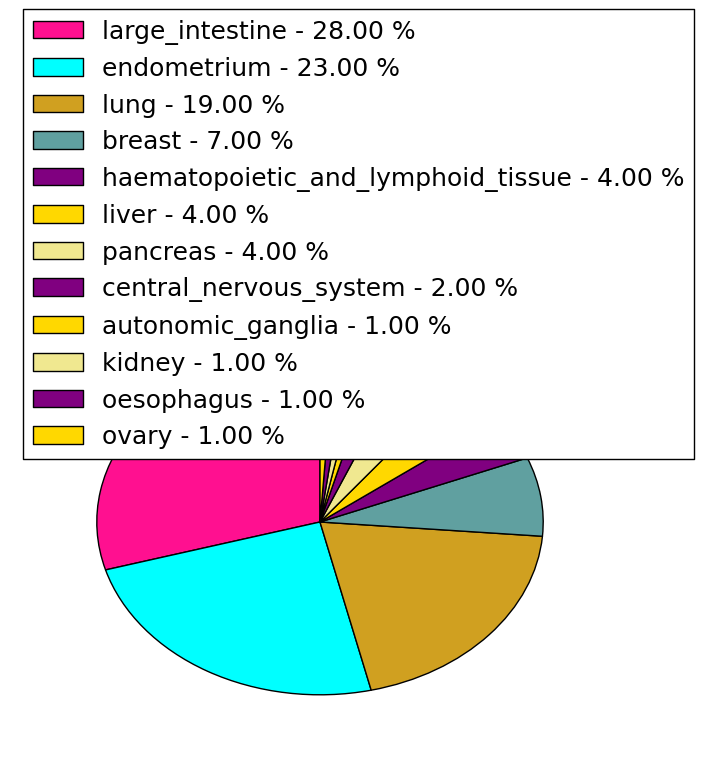 | 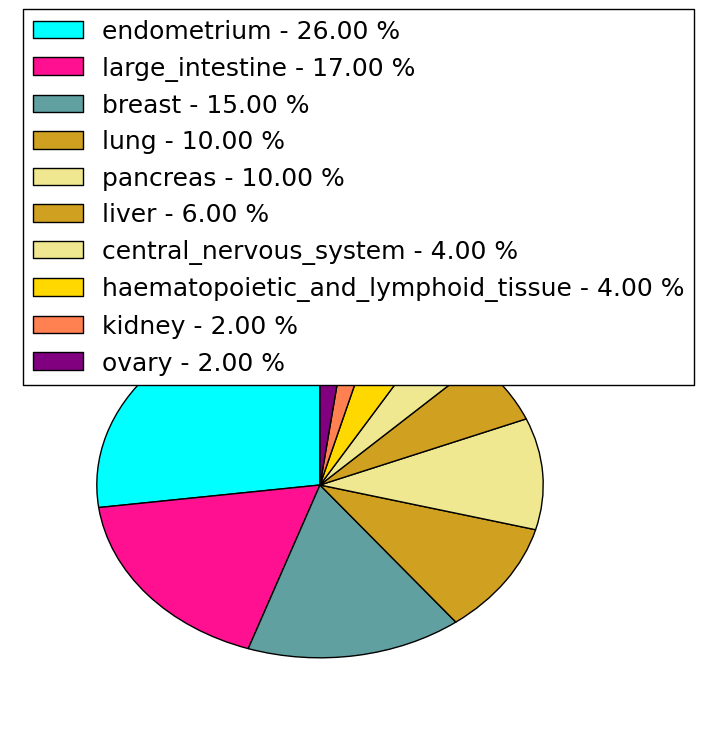 |
(# total SNVs=4) | (# total SNVs=1) |
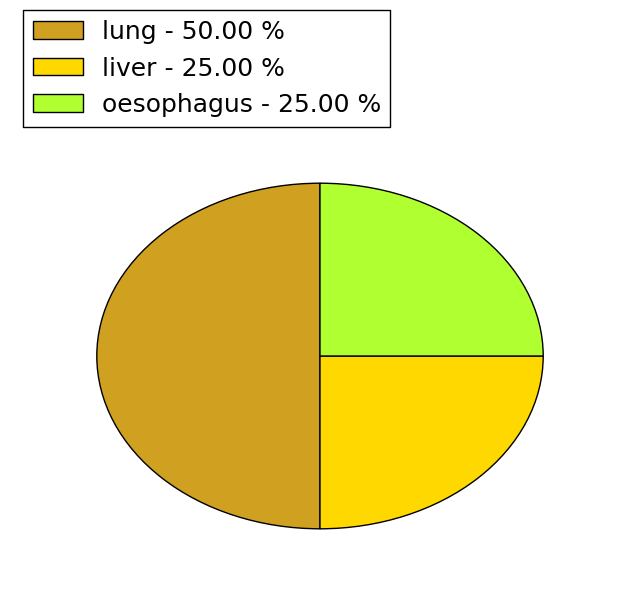 | 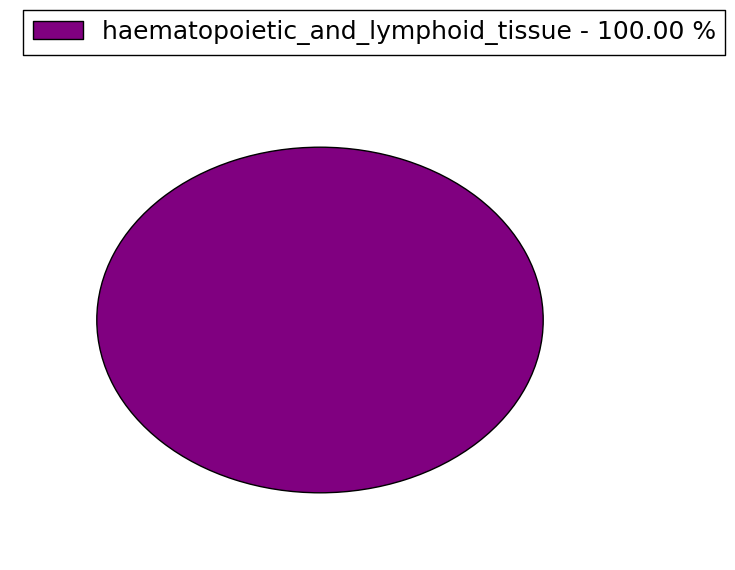 |
| Top |
| * When you move the cursor on each content, you can see more deailed mutation information on the Tooltip. Those are primary_site,primary_histology,mutation(aa),pubmedID. |
| GRCh37 position | Mutation(aa) | Unique sampleID count |
| chr12:133253184-133253184 | p.P286R | 15 |
| chr12:133250289-133250289 | p.V411L | 9 |
| chr12:133220532-133220532 | p.V1394A | 4 |
| chr12:133244137-133244137 | p.T757T | 3 |
| chr12:133250250-133250250 | p.L424I | 3 |
| chr12:133214643-133214643 | p.R1879C | 2 |
| chr12:133256154-133256154 | p.E169D | 2 |
| chr12:133245305-133245305 | p.E648K | 2 |
| chr12:133214671-133214671 | p.N1869N | 2 |
| chr12:133249237-133249237 | p.S554S | 2 |
| Top |
|
 |
| Point Mutation/ Tissue ID | 1 | 2 | 3 | 4 | 5 | 6 | 7 | 8 | 9 | 10 | 11 | 12 | 13 | 14 | 15 | 16 | 17 | 18 | 19 | 20 |
| # sample | 6 | 9 | 35 | 8 | 3 | 23 | 9 | 3 | 1 | 22 | 20 | 2 | 31 | |||||||
| # mutation | 7 | 9 | 37 | 9 | 3 | 32 | 9 | 3 | 1 | 23 | 27 | 2 | 49 | |||||||
| nonsynonymous SNV | 6 | 7 | 31 | 6 | 3 | 26 | 6 | 2 | 12 | 19 | 1 | 35 | ||||||||
| synonymous SNV | 1 | 2 | 7 | 3 | 6 | 3 | 1 | 1 | 11 | 8 | 1 | 14 |
| cf) Tissue ID; Tissue type (1; BLCA[Bladder Urothelial Carcinoma], 2; BRCA[Breast invasive carcinoma], 3; CESC[Cervical squamous cell carcinoma and endocervical adenocarcinoma], 4; COAD[Colon adenocarcinoma], 5; GBM[Glioblastoma multiforme], 6; Glioma Low Grade, 7; HNSC[Head and Neck squamous cell carcinoma], 8; KICH[Kidney Chromophobe], 9; KIRC[Kidney renal clear cell carcinoma], 10; KIRP[Kidney renal papillary cell carcinoma], 11; LAML[Acute Myeloid Leukemia], 12; LUAD[Lung adenocarcinoma], 13; LUSC[Lung squamous cell carcinoma], 14; OV[Ovarian serous cystadenocarcinoma ], 15; PAAD[Pancreatic adenocarcinoma], 16; PRAD[Prostate adenocarcinoma], 17; SKCM[Skin Cutaneous Melanoma], 18:STAD[Stomach adenocarcinoma], 19:THCA[Thyroid carcinoma], 20:UCEC[Uterine Corpus Endometrial Carcinoma]) |
| Top |
| * We represented just top 10 SNVs. When you move the cursor on each content, you can see more deailed mutation information on the Tooltip. Those are primary_site, primary_histology, mutation(aa), pubmedID. |
| Genomic Position | Mutation(aa) | Unique sampleID count |
| chr12:133253184 | p.P286H | 10 |
| chr12:133250289 | p.V411L | 8 |
| chr12:133220532 | p.V1394A | 4 |
| chr12:133250250 | p.S297F | 3 |
| chr12:133253151 | p.L424V | 3 |
| chr12:133210876 | p.A1967V | 2 |
| chr12:133248877 | p.S459F | 2 |
| chr12:133214643 | p.R1308R | 2 |
| chr12:133225973 | p.G1425G | 2 |
| chr12:133249847 | p.R1111Q | 2 |
| * Copy number data were extracted from TCGA using R package TCGA-Assembler. The URLs of all public data files on TCGA DCC data server were gathered on Jan-05-2015. Function ProcessCNAData in TCGA-Assembler package was used to obtain gene-level copy number value which is calculated as the average copy number of the genomic region of a gene. |
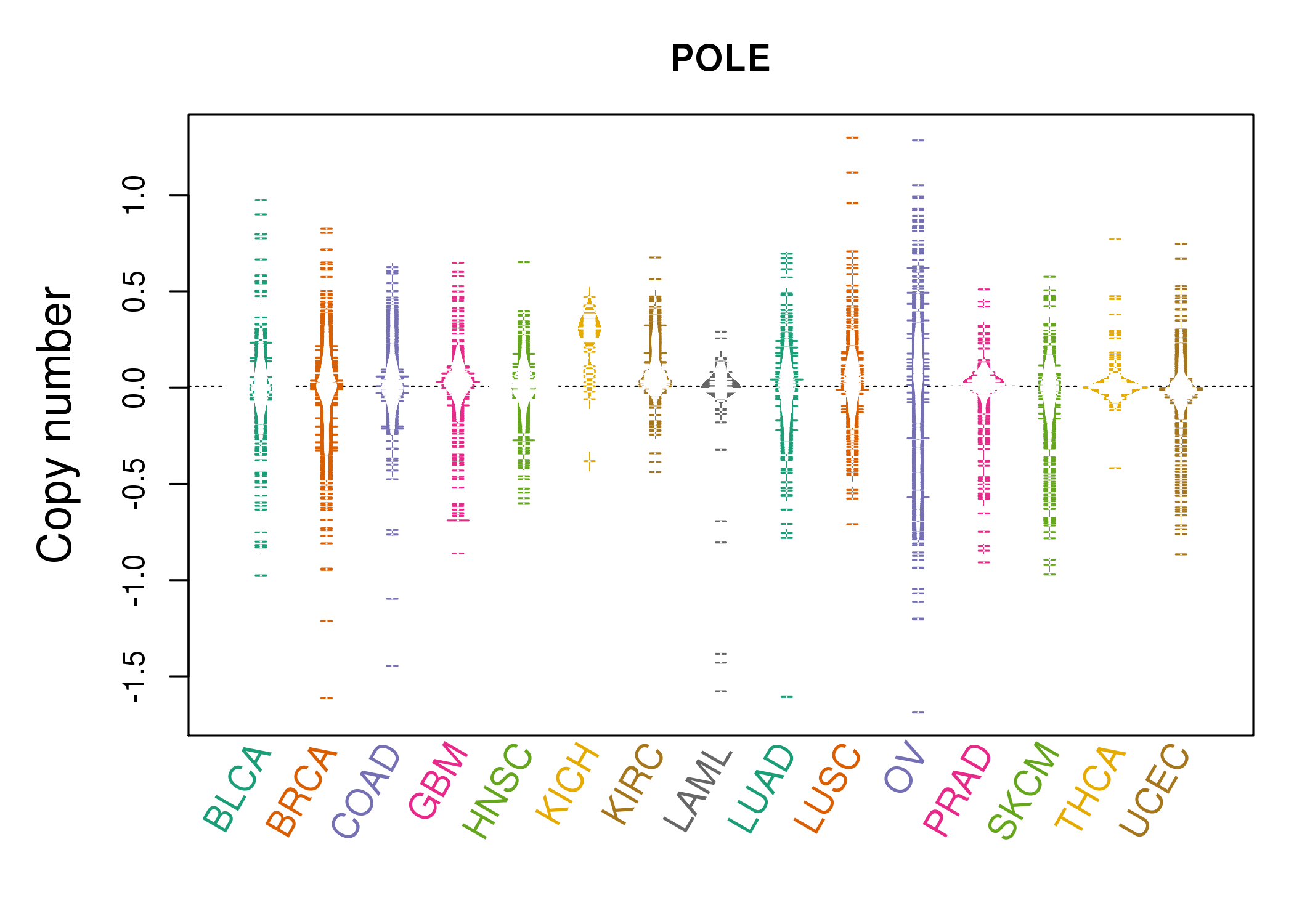 |
| cf) Tissue ID[Tissue type]: BLCA[Bladder Urothelial Carcinoma], BRCA[Breast invasive carcinoma], CESC[Cervical squamous cell carcinoma and endocervical adenocarcinoma], COAD[Colon adenocarcinoma], GBM[Glioblastoma multiforme], Glioma Low Grade, HNSC[Head and Neck squamous cell carcinoma], KICH[Kidney Chromophobe], KIRC[Kidney renal clear cell carcinoma], KIRP[Kidney renal papillary cell carcinoma], LAML[Acute Myeloid Leukemia], LUAD[Lung adenocarcinoma], LUSC[Lung squamous cell carcinoma], OV[Ovarian serous cystadenocarcinoma ], PAAD[Pancreatic adenocarcinoma], PRAD[Prostate adenocarcinoma], SKCM[Skin Cutaneous Melanoma], STAD[Stomach adenocarcinoma], THCA[Thyroid carcinoma], UCEC[Uterine Corpus Endometrial Carcinoma] |
| Top |
| Gene Expression for POLE |
| * CCLE gene expression data were extracted from CCLE_Expression_Entrez_2012-10-18.res: Gene-centric RMA-normalized mRNA expression data. |
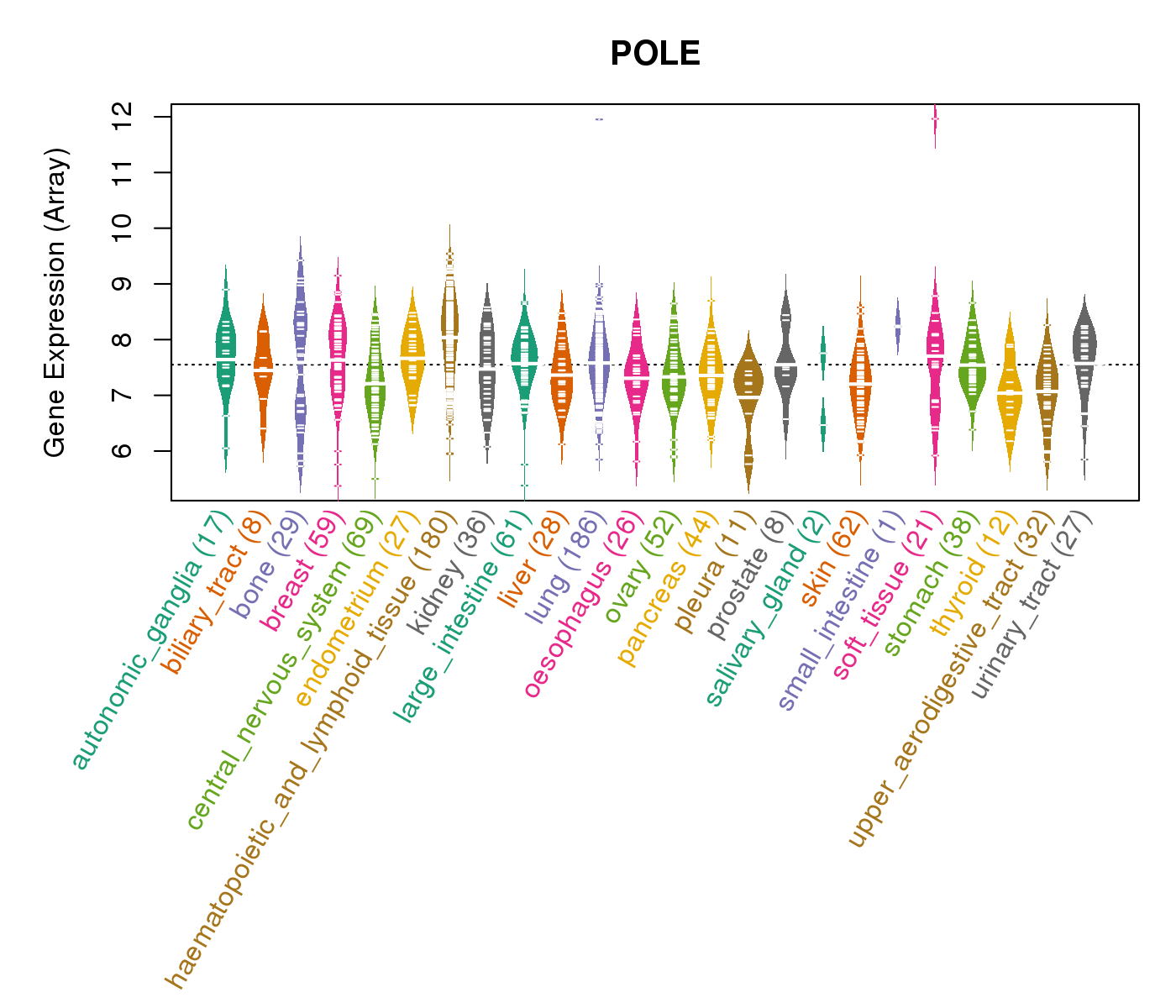 |
| * Normalized gene expression data of RNASeqV2 was extracted from TCGA using R package TCGA-Assembler. The URLs of all public data files on TCGA DCC data server were gathered at Jan-05-2015. Only eight cancer types have enough normal control samples for differential expression analysis. (t test, adjusted p<0.05 (using Benjamini-Hochberg FDR)) |
 |
| Top |
| * This plots show the correlation between CNV and gene expression. |
: Open all plots for all cancer types
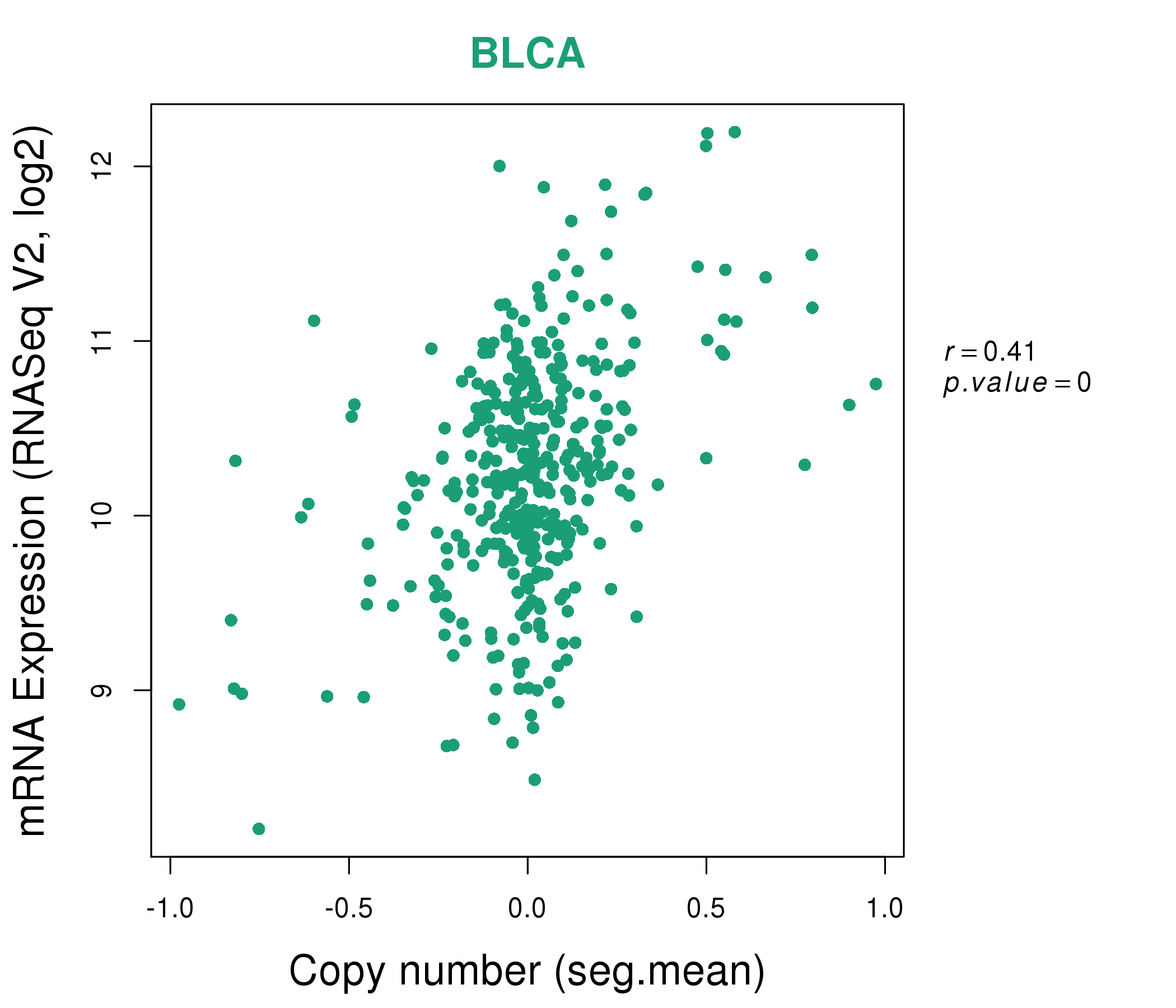 |
|
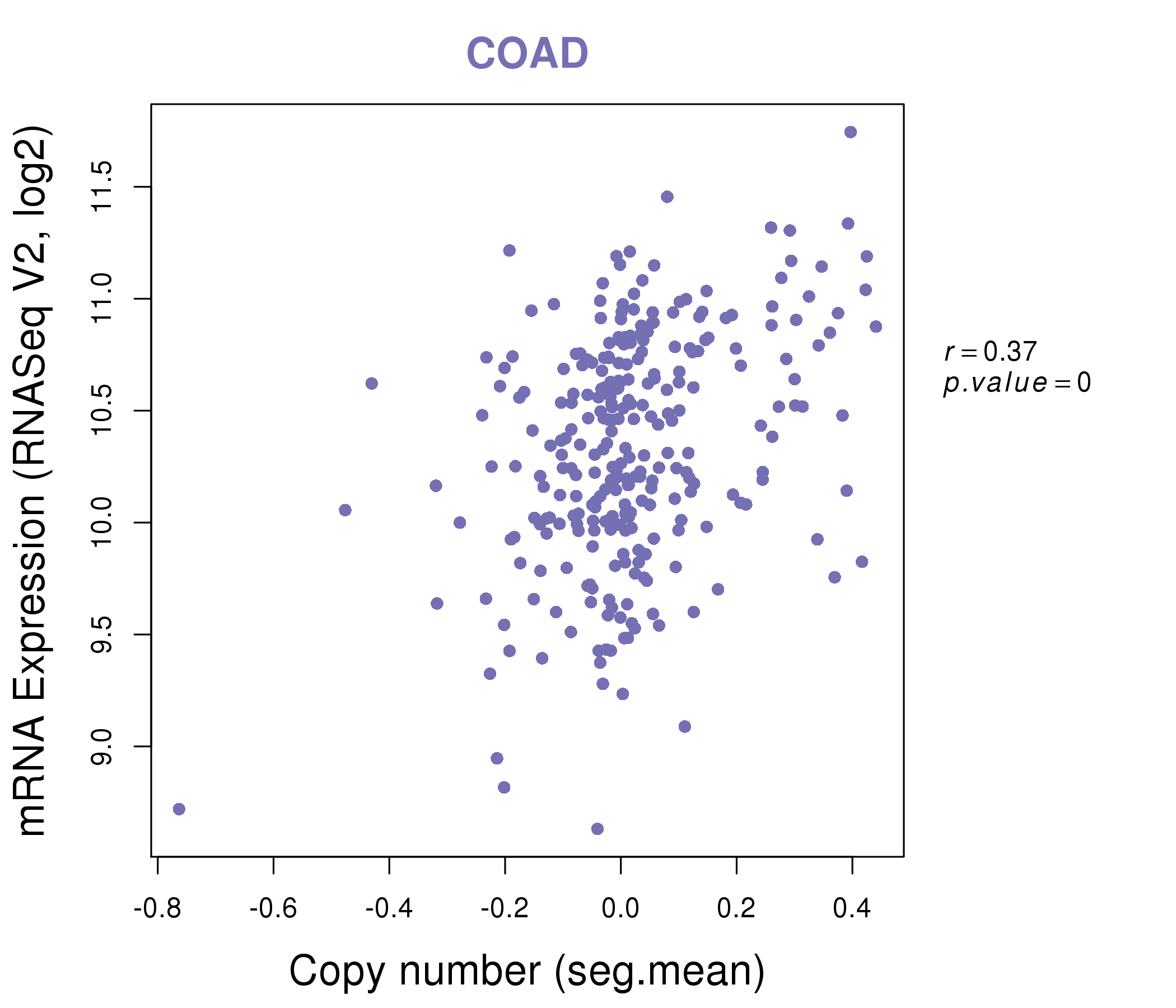 |
|
| Top |
| Gene-Gene Network Information |
| * Co-Expression network figures were drawn using R package igraph. Only the top 20 genes with the highest correlations were shown. Red circle: input gene, orange circle: cell metabolism gene, sky circle: other gene |
: Open all plots for all cancer types
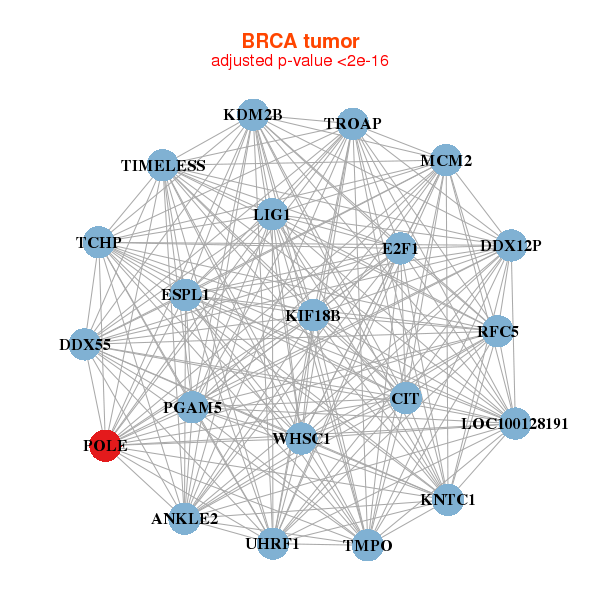 |
| ||||
| ANAPC11,AP2S1,C19orf24,C19orf70,CHCHD5,COMMD4,FDX1L, GADD45GIP1,JOSD2,MRPL53,LINC00116,NDUFA11,NDUFA13,NDUFB2, NDUFB7,POLE4,RNF181,RPS19BP1,TIMM13,TMEM160,UQCR11 | ATP5E,ATP6V0E1,ATP6V1F,MINOS1,BRK1,CAPNS1,DYNLRB1, KRTCAP2,MGST2,NEDD8,NOP10,OST4,PKIG,POLE4, RBX1,RNASEK,RNF181,SERF2,SRP14,TAF10,VKORC1 | ||||
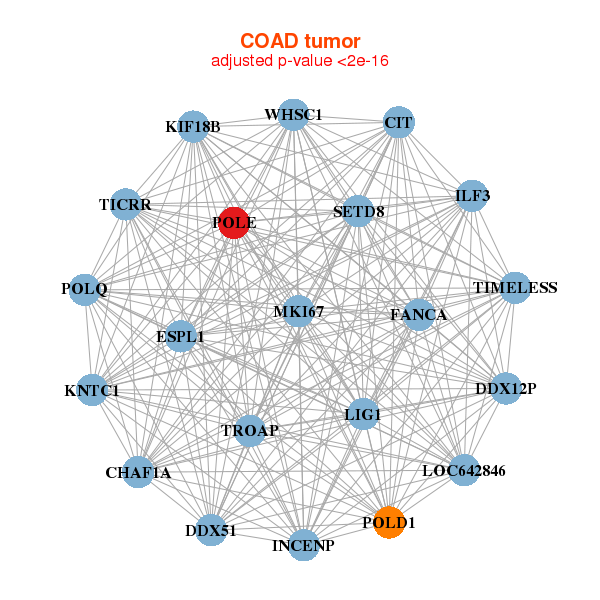 |
| ||||
| ANAPC11,UQCC3,ATRAID,PTRHD1,C7orf55,DTYMK,ISCA2, MRPL11,MRPS28,MYEOV2,LINC00116,NDUFB1,NDUFB2,NDUFB7, OST4,POLE4,SIVA1,STRA13,PAM16,TIMM8B,UQCR11 | ATP5O,BUD31,COX14,CAPZA2,COMMD3,FIS1,GOLGA7, NDUFA11,NDUFA13,NDUFA8,NDUFB7,NDUFS4,NFU1,PEX2, POLE4,SRP14,SUPT4H1,TMEM14C,TRAPPC3,UQCR11,ZNF410 |
| * Co-Expression network figures were drawn using R package igraph. Only the top 20 genes with the highest correlations were shown. Red circle: input gene, orange circle: cell metabolism gene, sky circle: other gene |
: Open all plots for all cancer types
| Top |
: Open all interacting genes' information including KEGG pathway for all interacting genes from DAVID
| Top |
| Pharmacological Information for POLE |
| DB Category | DB Name | DB's ID and Url link |
| Chemistry | ChEMBL | CHEMBL2363042; -. |
| Organism-specific databases | PharmGKB | PA277; -. |
| Organism-specific databases | CTD | 5426; -. |
| * Gene Centered Interaction Network. |
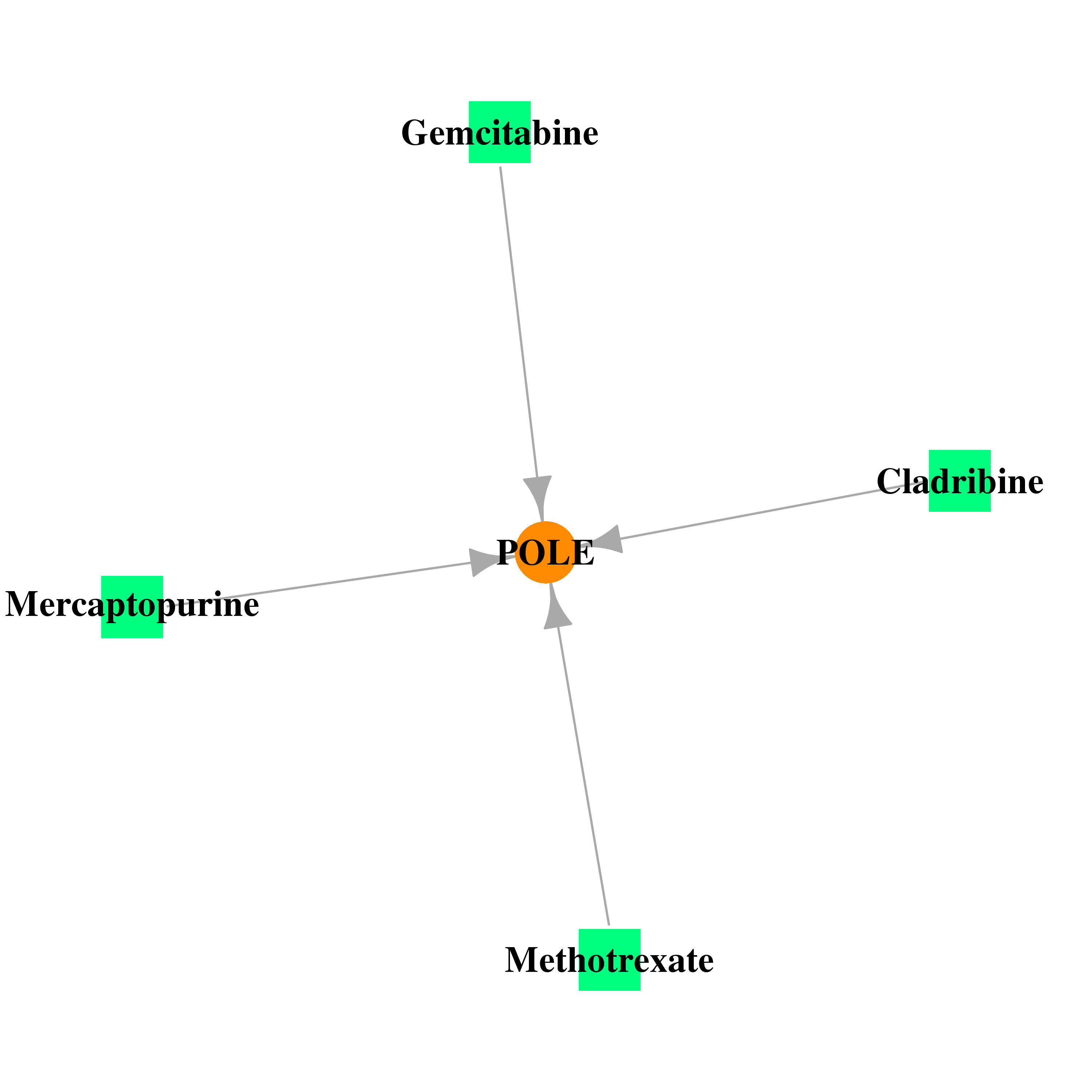 |
| * Drug Centered Interaction Network. |
| DrugBank ID | Target Name | Drug Groups | Generic Name | Drug Centered Network | Drug Structure |
| DB00242 | polymerase (DNA directed), epsilon, catalytic subunit | approved; investigational | Cladribine |  | 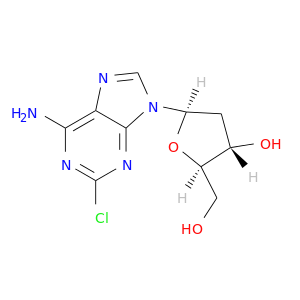 |
| DB01033 | polymerase (DNA directed), epsilon, catalytic subunit | approved | Mercaptopurine | 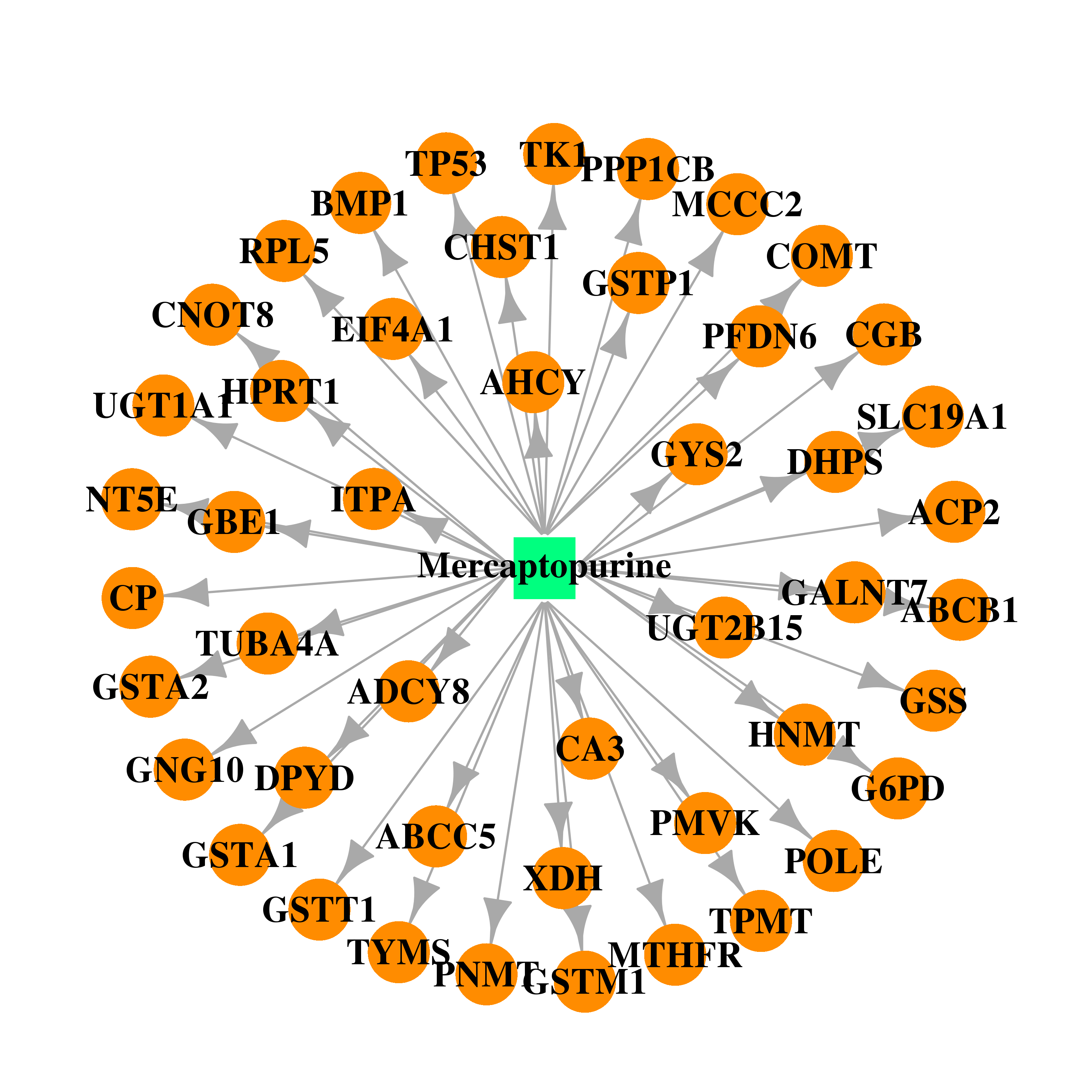 |  |
| DB00563 | polymerase (DNA directed), epsilon, catalytic subunit | approved | Methotrexate | 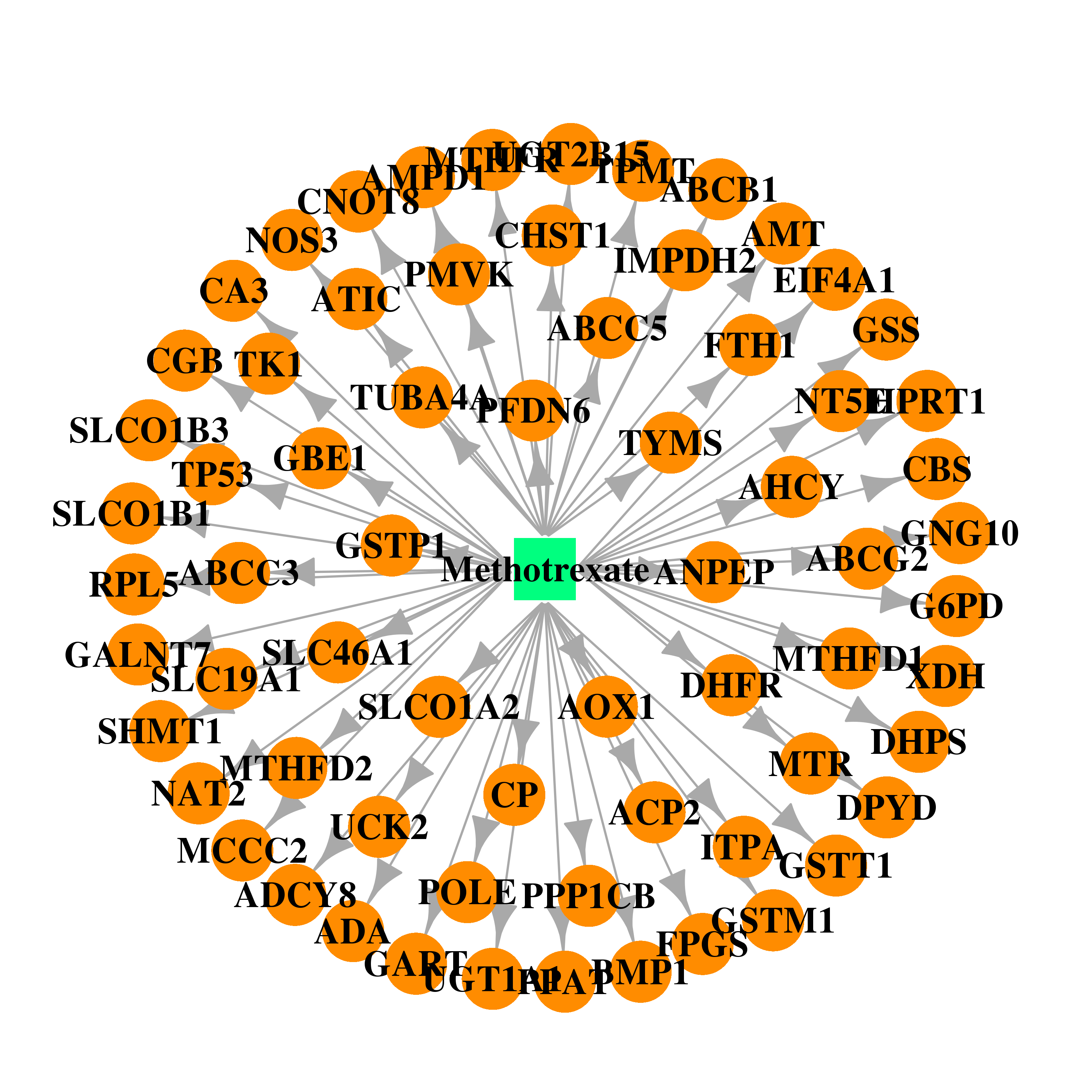 | 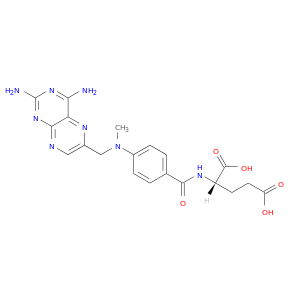 |
| DB00441 | polymerase (DNA directed), epsilon, catalytic subunit | approved | Gemcitabine | 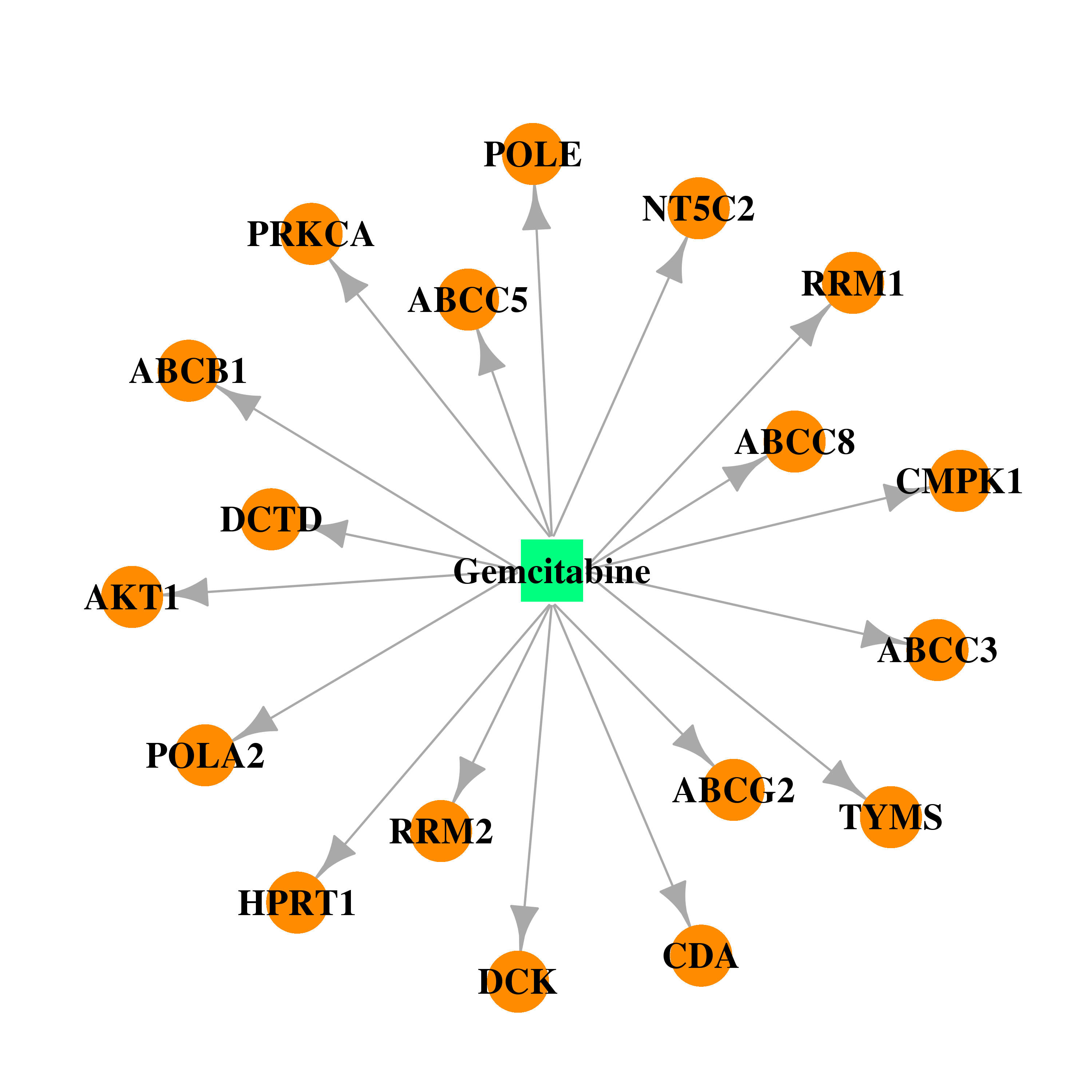 | 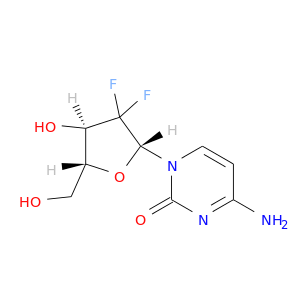 |
| Top |
| Cross referenced IDs for POLE |
| * We obtained these cross-references from Uniprot database. It covers 150 different DBs, 18 categories. http://www.uniprot.org/help/cross_references_section |
: Open all cross reference information
|
Copyright © 2016-Present - The Univsersity of Texas Health Science Center at Houston @ |







